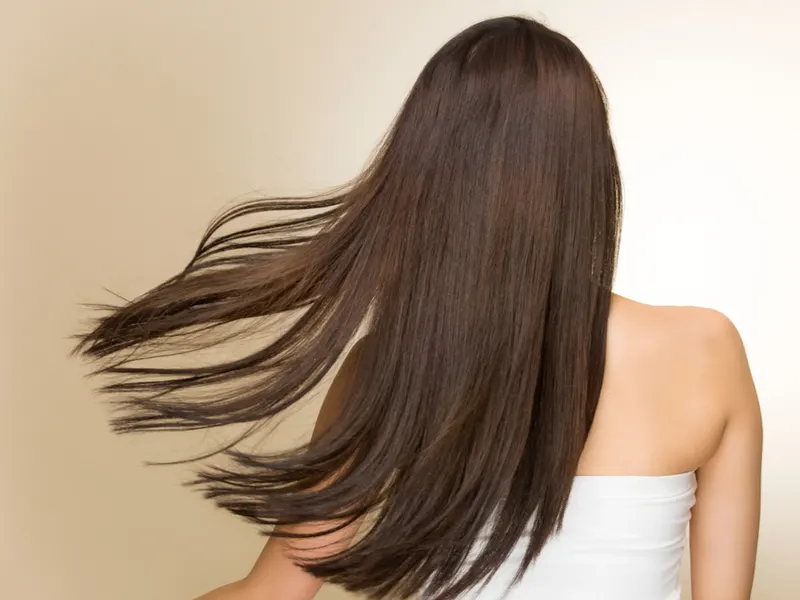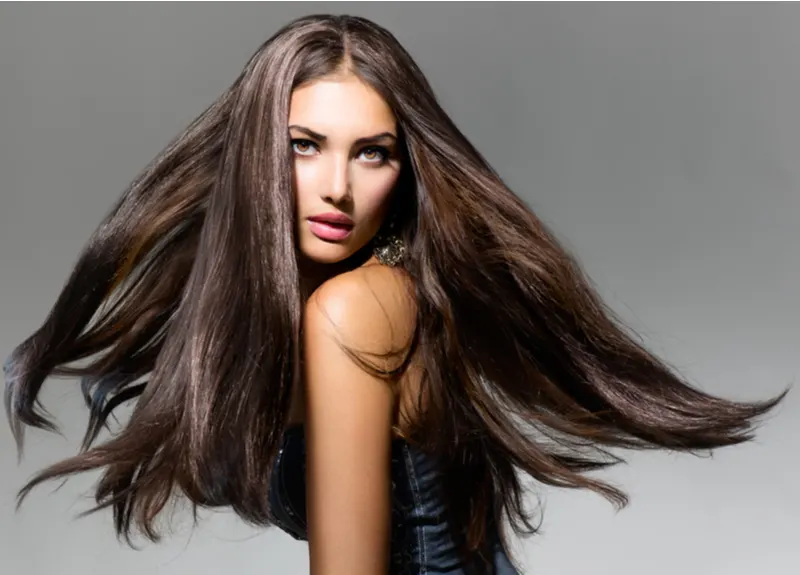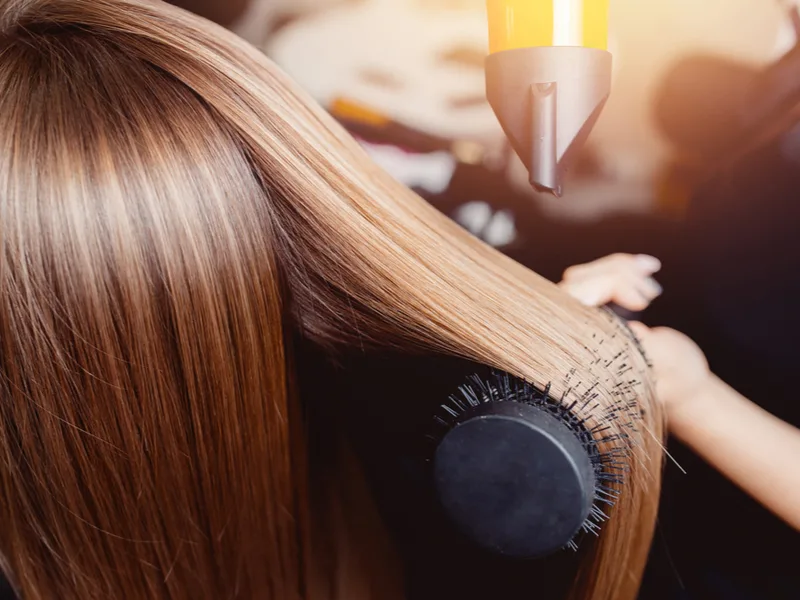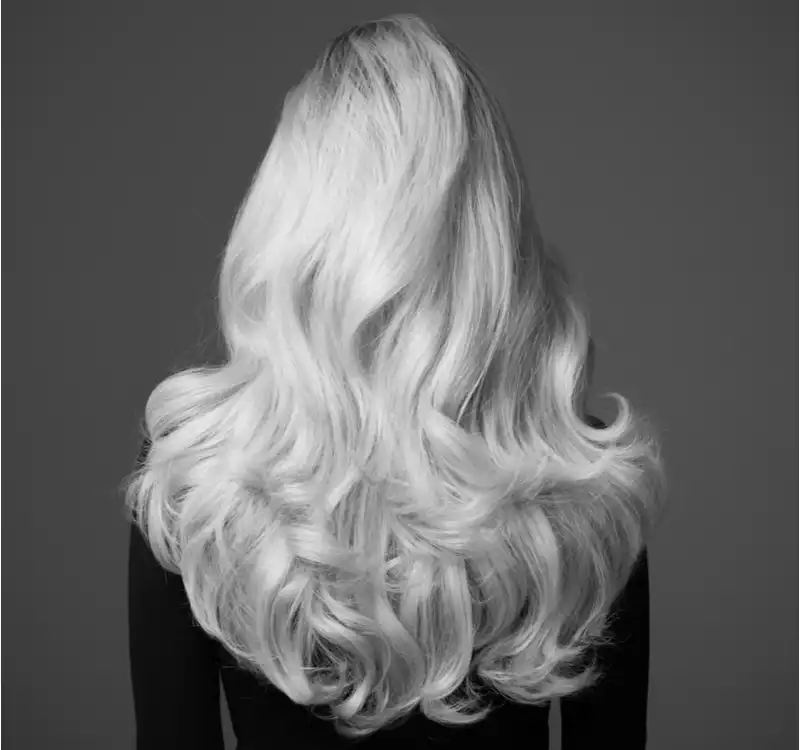Jump to:
With coarser strands and mostly straight/slightly tousled texture, the 1C hair type is often mistyped as a type 2A or 1B. Learn about this little-known hair type and what your 1C hair needs to look and feel its best (sans frizz) in our quick reference care guide!
What Is the 1C Hair Type?

kei907/Shutterstock
The 1C hair type is known for its mostly straight, softly tousled shape featuring slight bends and more body than 1A and 1B hair types. Even though the strand texture is usually coarse or medium-coarse, this hair type is known for being prone to oiliness soon after washing.
That’s due to the mostly straight shape of strands, which acts like a superspeedway for the natural oils produced by your scalp. But since the 1C hair type has a coarser (thicker) strand texture than other straight type 1s, it does take a little longer for 1C roots to appear greasy.
The 1C hair type is often mistyped as a 2A due to the presence of slightly tousled texture with a little bending and extra body. That’s why it’s important to note what features are unique to this hair type.
Here are the general characteristics of 1C hair:
- Mostly straight strands with extra body and some bending from midshaft to ends
- Medium-coarse to coarse strand texture
- Not as shiny as 1A and 1B hair types
- Prone to oiliness soon after washing
- Appears very thick, full, and voluminous
- Easily holds a curl due to coarser strands
The presence of tousled texture with a little bending makes it easy to misidentify this hair type with wavy type 2A. But that hair type could more accurately describe your hair if you are missing the 1C coarse texture. Here’s a look at what features are common with each of the similar hair types:
- Type 1B: Medium texture, slight bends from midshaft to ends, prone to oiliness and struggles to hold a curl without products
- Type 1C: Medium to coarse texture, slightly tousled/bendy texture without full waves, prone to oiliness at the roots and easily holds a curl
- Type 2A: Fine to medium texture with soft, inconsistent waves that are enhanced with products; prone to oiliness at the roots
If you’re not sure which type most accurately covers the features and characteristics of your mane, take our quiz to find out your true hair type now: 3 Short Questions Hair Type Quiz
Keep reading to learn all about the 1C hair type, including the best and worst features, how to care for and maintain this hair type, and tips for better hair days.
Best Features of 1C Hair
What’s awesome about having 1C hair? A lot of things, actually. But we’ve tried to narrow it down to 3 to keep things brief. Here are a few things anyone with 1C hair can be thankful for.
Naturally Tousled Texture
Type 1C hair sports a naturally tousled texture that isn’t pin-straight or wavy. It’s this happy medium where you get straight roots with slight bending that begins midshaft and into the ends.
If you’re a fan of casual, low-maintenance texture (and we are), the 1C hair type is ideal. Type 1C hair dries in its trademark tousled state with or without products.
Unlike wavy hair types that may require special techniques to fully form waves (rake and shake, scrunching, etc.), your 1C strands do their thing without any input or effort from you. And that, friends, is a beautiful thing.
Strand Strength Makes It Easy to Achieve Length
The 1C hair type is naturally strong since it doesn’t curl or angle like type 3s and 4s. Every curl or angle in a hair strand becomes a weak point where breakage is likely.
Since your 1C strands don’t fully wavy, curl, or coil, you don’t have these weak points and your strands are much stronger as a result. Strong strands that don’t easily break off make it easy to achieve longer lengths.
If you’re actively growing your hair out, you won’t be losing precious length to breakage as much as other hair types. So your length is able to accumulate faster, getting you to your growth goals sooner!
Using a protein-enriched hair mask once a month or so can help add even more strength and breakage resistance to 1C hair, helping you grow it longer in less time. See our favorite hair masks for damaged hair here.
Coarse Texture Is Naturally Damage Resistant
The coarse or medium-coarse texture of 1C hair makes it naturally damage resistant. That’s because coarse hair features an entire inner layer that fine and medium hair don’t have: The medulla.
Fine and medium hair have the two outer layers (the cuticle and cortex). But only coarse hair has all 3 layers. The innermost, spongy medulla is able to hold onto moisture and help prevent many types of damage from taking effect as quickly as it can in finer hair types.
Think of it this way: It’s easy to burn thin chips of wood, but takes much longer to burn a thick log. Likewise, your thicker, coarse hair takes longer to accumulate heat, chemical, and physical damage than finer (thinner) hair types.
Worst Features of 1C Hair
While 1C hair has its shining moments, it’s not always easy dealing with this hair type. There are a few challenges unique to this hair type. We’ll cover the most common challenges below.
Prone to Oiliness
Your straight strand shape makes it very easy for oil to travel from your scalp’s sebaceous glands to your roots and along each strand. That’s great for shine and moisture, but bad for keeping your roots voluminous and clean.
Since oil quickly accumulates at your roots, you may find yourself washing your hair more often to get rid of the greasy look. Washing more often strips your hair of all its natural moisture and creates an oil feast-famine cycle.
When 1C hair starts looking greasy a day or two after washing it, you’ll likely wash it again to remove the oily buildup and achieve clean roots. Once your scalp “detects” that all the oil has been stripped away, it produces even more oil to make up the difference.
This will force you to wash it again to remove the excess oil, and the cycle continues. Don’t worry! We’ve got tips for managing oiliness in the Maintenance and Care Tips section below.
Prone to Frizz
The 1C hair type is typically coarser in texture, and coarse hair is more prone to frizz than finer hair. Frizz will be compounded if chronic dryness is an issue. For many oily type 1Cs who find themselves over-washing their hair in an effort to avoid oily roots, chronic dryness often is an issue.
Frizz prevents styles from looking smooth and sleek. Frustrating frizz can give your hair a messier appearance, even if you’ve taken the time to heat style or air dry into heatless waves or curls.
There are a few ways to combat frizz successfully, including washing less often, providing adequate moisture for strands, and using anti-frizz serum before drying and styling your hair.
Read Next: How to Get Rid of Frizzy Hair
May Experience “Fluffy” Volume
Since 1C hair is coarse and tends to be very dense and thick, it’s got a lot of natural volume. That natural volume can appear “fluffy” or “poofy” in the wrong conditions (like on a humid day or when your hair is under-moisturized).
You might find that it’s hard to nail smooth, sleek styles, even when you flat iron or use an anti-frizz product to control your strands. Taming fluffy volume without flattening your hair requires getting your hair’s moisture balance right. We’ll talk more about this in the next section.
Maintenance and Care Tips for 1C Hair
Caring for the 1C hair type really centers around 3 things: Providing the right amount of moisture, balancing oil production, and perfecting air dry techniques for more consistent strand shape.
Washing 1C Hair
- Wash every 3-4 days with lightweight shampoo
- Use dry shampoo in between wash days
- Condition midshaft to ends only
- Deep condition once a month
You should try to wash 1C hair every 3-4 days, or as long as you can go before it looks greasy. Using a specially-formulated shampoo for oily hair can help extend your time between washes and limit your scalp’s natural oil production without drying your strands out too much.
Dry shampoo is one product you absolutely need to have on-hand. If your roots start getting oily before it’s time for your next wash, you can spray a little dry shampoo to soak up oil and inject a little volume.
We list our favorite oil-fighting options here: The 7 Best Dry Shampoos for Oily Hair in 2022. It’s easy to think you don’t need conditioner when you have oily 1C hair, but don’t fall into that trap.
Using conditioner after shampooing will help keep your ends and midshaft zone moisturized since oil doesn’t always make its way that far down your strands. Condition your midshaft to ends, or your ends only, to help restore your hair’s moisture balance.
You should also deep condition your hair once a month to help restore your hair’s natural moisture balance. This can help control your oil production by keeping your hair deeply moisturized and reducing your sebaceous glands’ need to produce excess oil.
Read the deep conditioning guide next to learn more: How to Deep Condition Hair Step-by-Step.
Drying 1C Hair
- Air dry most of the time with limited blow drying
- Experiment with different air dried styles
- Apply heat protectant before blow drying or heat styling
- Use anti-frizz serum to minimize frizz
After cleansing and conditioning 1C hair, you have two basic options for drying it: Air dry or blow dry. There are benefits and drawbacks to each method, so let’s take a closer look.
Air drying cuts out the potential for heat damage. It’s the healthiest option for your hair, but it can lead to increased frizz and the “fluffy” volume most of us try to avoid. A little anti-frizz serum can help minimize frizziness when air drying or blow drying, so keep a good one on-hand.
We like Garnier Fructis Sleek and Shine Anti-Frizz Serum the best for 1C hair. Blow drying has the potential to lead to heat damage over time, but your coarse 1C strands are naturally more damage-resistant than finer hair types.
It’s perfectly fine to blow dry your hair, but we do recommend limiting how often you use this method. You should try to use the lowest heat setting and spray on or apply a heat protectant product before using heat to dry this hair type.
Styling 1C Hair
The options are endless for styling 1C hair. Your lack of natural waves and curls means you can adopt almost any texture when you air dry or heat style without a ton of effort. Your hair’s coarse texture makes it easy to make heat styled waves and curls stay put for a day or two.
Since your tousled/mostly straight strands can take on a casual or messy look when air dried, you might appreciate heatless waves and curls methods. Try weaving your hair into equally-sized braids or winding it into twists or buns while it’s still damp.
Sleep on the style, then take it down in the morning to reveal perfectly styled waves or curls. If you’re not a fan of “overnight” air dry styles and want results quicker, heat styling is always an option for 1C hair.
Since you’re naturally more resistant to damage thanks to the presence of the third innermost layer of hair (the medulla), heat styling won’t harm your hair as quickly as it can finer hair. Here are some of our favorite ways to style 1C hair.
Air Dry With Natural Texture

Subbotina Anna/Shutterstock
Your naturally tousled texture is the perfect candidate for air drying. Brush through gently while it’s damp and apply a small amount of anti-frizz serum. Keep your hands out of your hair as it dries to keep frizz to a minimum and let your natural texture shine!
Give Yourself a Blowout

Parilov/Shutterstock
Hair blowouts are so beautiful on 1C hair. Your naturally coarse strands respond well to being shaped with a combination of heat and the closely-spaced bristles of a round brush. Apply a little anti-frizz serum before sectioning your hair into 4 equal pieces.
Starting with the back sections, keep your dryer pointed downward and bring the round brush up underneath to dry and smooth each section. Finish with the front sections, curving the hair away from your face for the most flattering look!
Try Heatless Bun Curls

YuriyZhuravov/Shutterstock
Subtle curls at the ends of your hair is a great look for 1C strands. Since your coarse strands hold textured styles well, this heatless curl method can give you curls that last 2+ days with no touch-ups. Brush through your damp hair and apply a little anti-frizz serum.
Gather your hair at the nape of your neck and twist it into a long coil. Wind the coil around itself to form a loose bun and secure with a scrunchy or clip. Wait until it’s fully dry, then take the bun down to reveal loose, big ringlets at the ends!
The 1C Hair Type: Final Thoughts
We’ve covered the good, the bad, and the best methods to wash, dry, and style your 1C hair. Before you head off to try one of our recommended styles or grab that anti-frizz serum, we have a few more tips for you to keep in mind.
- Damage-resistant is not immune to damage. Your coarseness makes your strands more resistant to damage, but it’s not impervious. You should still use heat protectant, low heat settings, and limit chemical processing to keep your strands healthy.
- Enhance your tousled texture with salt. Your hair is still straight, but with enough bend in it to be very close to wavy. You can boost your tousled texture with sea salt sprays, homemade or store bought. Make sure to thoroughly wash your hair after using and follow with your monthly deep conditioning treatment to avoid drying out your strands.
- Pay attention to your ends. While your roots can get greasy, oil rarely travels all the way down your strands to moisturize your ends. Deep conditioning once a month and focusing conditioner on your ends during showers will help keep your ends pliable and soft.
- Use less of each product. If you have a small range of products you use in your hair, try using a little less of each one to see if you get better results. Cut down on how much shampoo, conditioner, and anti-frizz serum you use to experiment. You may only need a pea-sized amount of anti-frizz serum, a quarter-sized amount of shampoo, and a small amount of conditioner to get ideal results.
You’ve got the skinny on caring for 1C hair, but if you’re not 100% sure this is your hair type, now’s a good time to double check.
Take our quiz to find your true hair type and get specific tips to make your hair look and feel its best next: Take Our Hair Type Quiz | It’s Only 3 Short Questions!
